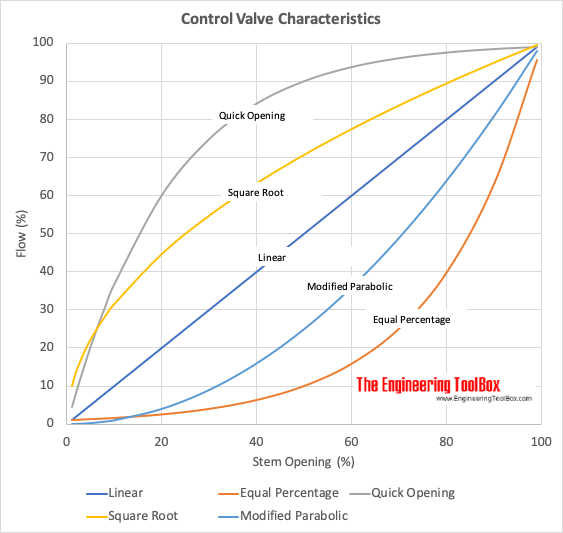
Image Source: Tameson
Ball valves may be fitted in either a vertical or horizontal pipe run since they are bidirectional, thus the direction of flow is not strictly necessary. However, it is generally recommended that the valve handle be oriented such that it opens in the direction of flow.
ball valve flow rate chart

Image Source: The Engineering Tool Box
The flow via a ball valve is controlled by a hollow ball within a quarter-turn valve. The ball’s hole may be aligned with the flow direction by rotating the valve 90 degrees; in the closed position, the valve will fully cut off the flow.
From the top of the ball, a stem protrudes through a seal and may be connected to a handle or a pneumatic/electric actuator. Besides its more common ON/OFF function, ball valves may also be used to control the flow of a fluid.
ball type flow control valves

Image Source: Raccord Plast
A ball valve is a kind of shutoff valve in which a rotatable ball inside a bore is used to regulate the flow of a liquid or gas through the valve
Ball valves are often employed in flow systems across a wide variety of sectors due to these reasons:
- Cheap price
- Longevity
- Great shutdown capability
- High levels of accuracy and control of fluid movement
Are control valves all ball valves?
Media flow via the pipeline may be initiated and terminated using either ball valves or control valves. While ball valves can’t be used for throttling, control valves can. Also, the on-off functionality of a ball valve may be replicated in a needle valve.
When it comes to flow regulation, globe valves are the gold standard, while on the other hand, ball valves are preferable for on/off control with little pressure loss.
What and where is a control valve used for
Water flow control valves are used to manage the flow of liquids and gases such gas, oil, water, and steam. It’s the last piece of the control puzzle, but it’s an essential one. Most modern industrial applications make use of control valves as their last line of defense.
Ball valve Vs. Needle valve advantages & disadvantages
Below is a table where you can compare both needle and ball valves:
| Categories | Needle Valves | Ball Valves |
| Fluid Flow | A needle valve improves flow control. | Ball valves are better for high-pressure use. |
| Applications | Needle valve is appropriate for small-volume applications, but it clogs easily | Because of the ball’s construction, thick fluid flows slowly. |
| Usage | This valve is simple to operate | Ball valves let you switch a system on and off |
| Design | Needle Valve is tiny. | Multiple ports on ball valves allow for numerous porting combinations. |
How a flow control valve works
As the variables they regulate rise, the valves shut to limit the changes. A rise in demand causes the flow rate to decrease gradually via the valve, making this a “progressive” process. As the valve is tightened, the pressure downstream drops.
Looking for control ball valve manufacturer
You need go no farther than this valve manufacturer to get a wide selection of valves such as fisher v vall valve, bray v-port ball valve and many more to outfit your mechanics. If you have any questions, Xhval, a v-port ball valve manufacturer which has helpful customer service is there for you.
